Partition 1947: Lessons we need to un/learn
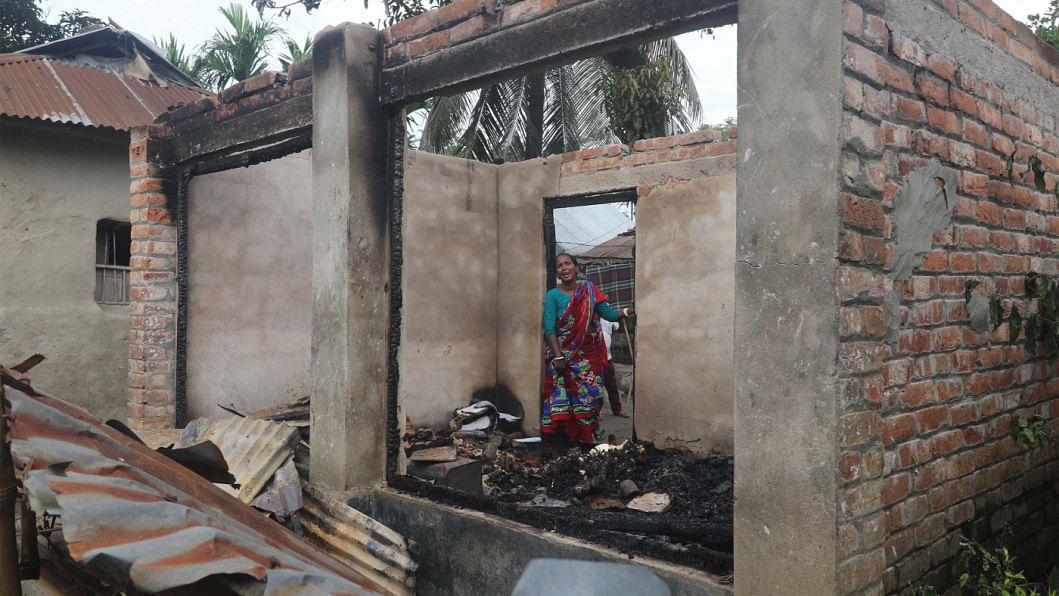
Seventy-six years after the Partition of the Indian subcontinent, we are still a long way from understanding the complex ways in which this event affected the everyday lives of people and communities then, and how it still continues to shape our collective consciousness, politics and ways of being. This series, featuring scholars of partition studies from across the subcontinent is an attempt at exploring the complexities and contradictions of the momentous event that forever changed the contours of this region. This article examines the indocentrism of partition studies and how we can accommodate diverse experiences and narratives from the peripheries.
Although Partition Studies began with contesting nationalist-statist narratives between India and Pakistan, in the last four decades, it has made critical engagement with such nationalist-statist accounts. Lately, Partition research has transcended the boundaries of nation-states and challenged their monoliths by accommodating varied experiences. This is a crucial achievement.
I can see at least three major threads in recent Partition research. The first one is the work of feminist oral historians like Urvashi Butalia, Ritu Menon, Kamla Bhasin and others who have brought up oral historical accounts of Partition survivors. For Veena Das, violence is neither meaningless nor an act of insanity. Instead, it often had been triggered to shape the nation and state. Drawing upon the painful experiences of women, therefore, unsettles the nationalist canvas of history.
The second thread is the interruptions by literary and creative genres. Fiction writers and filmmakers have engaged with Partition, where instead of confining themselves to the academic bureaucracy of publication and research, they enjoyed creative liberty. They wanted to transcend the experience of the nation and state and look into other experiences. Niaz Zaman, for example, compared the stories of Bangladesh with those of West Bengal.
The third and final thread is related to the decentralisation of Partition research. In the early years, it was focused on Punjab and Bengal remained neglected. While the experiences of Bengal were gradually seen, it came with a West Bengal-centric bias, and East Bengal/Bangladesh appeared on the margin. In recent years, however, we have witnessed divergent research interests and locations. Today, if one looks at issues of the Indian National Register of Citizens (NRC) in the Assam or Tripura context, one should acknowledge how the problem is related to the 1947 Partition. Accommodating the peripheries and their diversified narratives and experiences contributed to this decentralisation.
But even after these significant achievements, I would still say that Partition Studies has embraced an indocentric character. I am not imposing a homogeneity here – the field must contain diversity. Nevertheless, experiences from India reside at the centre, pushing away other experiences at the periphery of Partition Studies.
In the following discussion, I would like to identify four instances of indocentrism. The first one is the absolutisation or monopolisation of loss. Loss or negativity remains at the centre of Partition research over the years. Anything we say about 1947 is about shedding tears, rupture and truncation; suffering remains at the centre. While the experience of loss is not insignificant at all, by looking absolutely into the loss, Partition Studies becomes synonymous with a saga of loss. Such representation overshadowed other crucial aspects of Partition. If one looks into East Bengal, one finds that 1947 for them was jubilation too. At an abstract level, it was the assertion of a new identity; at a concrete level, it was that moment of accessing economic, social and cultural capital by Bangalee-Musalman.
Whether one likes it or not, the reality was that people in East Bengal embraced that new identity. Nilesh Bose argues that East Pakistani writers, authors and editors were keen to craft an East Pakistani identity that will be simultaneously Pakistani but Bengali. However, the category of Bangalee Musalman has its constant dilemma. On one hand, Pakistan was meaningful for many; on the other, this emotion for Pakistan was buried in the rise of secular Bengali nationalism. But that does not mean the fascination for Pakistan has all gone. Dina Siddiqi emphasises that Bengali Muslims had been struggling with double burdens. As Muslims, they had never been Muslim enough to Pakistanis. Likewise, as Bengali, they had never been Bengali enough to West Bengalis – they were either Bangal or Muslim. This dilemma of the Bangalee-Musalman identity has its roots in Partition but remains overlooked in Partition Studies. Without engaging with this, one would not understand the polity and society of South Asia. One has to transgress the saga of loss and look into other contrasting experiences of Partition.
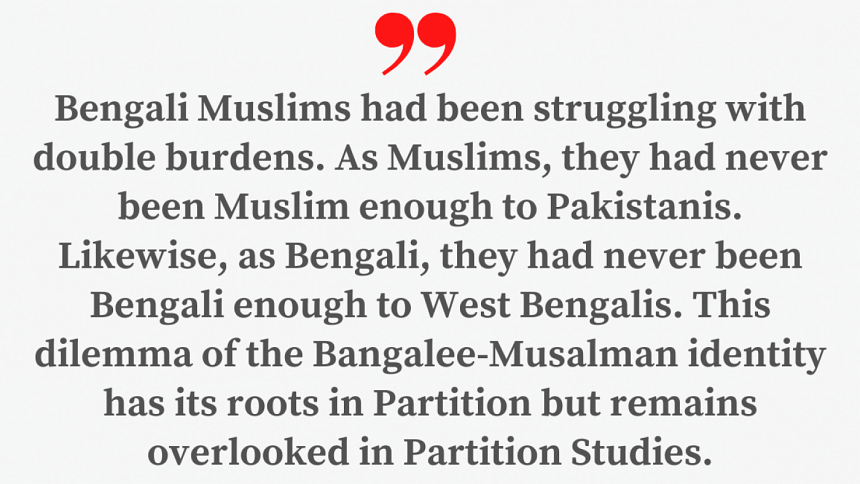
The second indocentric instance is the overexposed single-story about a particular episode of the East Bengal Partition – the exodus of the non-Muslim population from East Bengal to West Bengal/India. Accounts of exodus are invaluable, and there is no scope for denying the suffering of East Bengal's non-Muslims. Yet, fetishising a single story requires critical engagement too. Partition exodus was multi-directional. People also fled from Bihar, West Bengal and Uttar Pradesh and, like millions, they faced horrors and sufferings. But, until recently, we did not hear much about the exodus of the Biharis (popularly referred to as the divergent non-Bengali speaking emigres) of Bangladesh in Partition Studies. Punjab was an unknown place to them. Many of them used to visit East Bengal before Partition and the route was familiar. Therefore, they came to East Bengal and considered it their new homeland. They remember, "Jinnah Sahab told us that we got a broken Pakistan but we will make a golden Pakistan out of it."
Soon after arrival, they witnessed the rise of Bengali nationalism, and Pakistani rulers used Biharis against Bengalis. Eventually, the Biharis who survived 1947 at the cost of their blood and sweat were identified as the villains in East Bengal. In 1971, they became stateless when Pakistan, the country they had opted for, abandoned them. For almost four decades, they had no legal status. The overexposure of the non-Muslim exodus also compelled us to forget another section of people, the non-Muslims of East Bengal who stayed back, voluntarily or not. They became the minority twice: first in "Muslim" East Pakistan and later in "secular" Bangladesh. At the emergence of Bangladesh, based on Bangalee nationalism, non-Muslims hoped of escaping minority status. That hope is yet to come true. For how long will Partition Studies turn them away?
Thirdly, indocentrism is evident in Partition Studies concepts like "surgery" and "prolonged Partition". The metaphor of "surgery" draws upon a morphological explanation of nation as the body that requires amputation of its infected limb. It indicates that to save the nation, India had to separate the Muslims and Pakistan. Joya Chatterji argues how this concept of "surgery" fails to accommodate reality; it glosses on facts like the active participation of Indian and Pakistani actors in the process, implying that the British were the surgeon and India a mere passive patient body. Scholars argue that Partition is all about negotiation and calculated bargaining. The British were not impartial surgeons, and Indian actors like Congress and Muslim League were neither impartial, nor passive. Challenging this metaphor eventually departs from the notion that Muslims/Muslim League had the sole responsibility of Partition.
The other concept of "prolonged Partition" implies that Partition as a process was incomplete in 1947. It has consequences over the following generations and decades. About the Bengal Partition, it has been said that the border here is porous. India claims that through that porous border, people from Bangladesh enter India. Cross-border mobility and people living transborder lives is a reality along the Bengal borderland and "prolonged Partition" is therefore a worthwhile idea. However, instead of confining this concept to one specific instance, it should be stretched to other aspects – there are a few more issues that can be understood as "prolonged Partition".
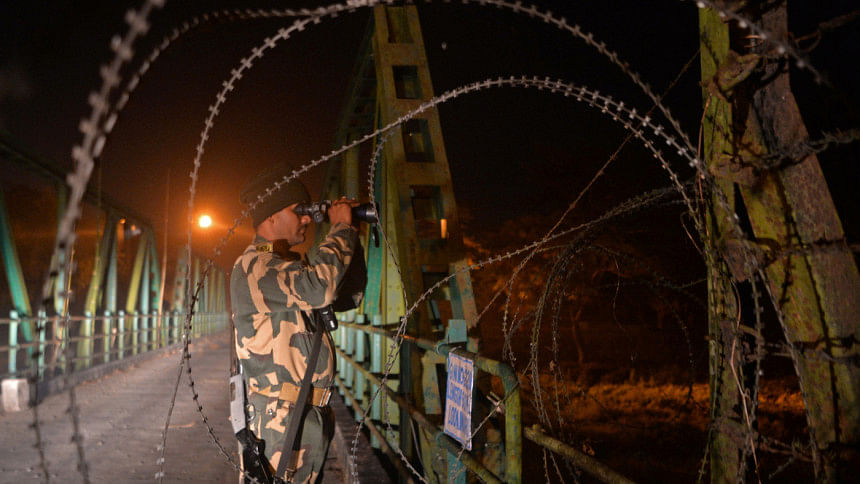
It is interesting to ask here, who kept the Bengal border porous? The Punjab border had to be sealed right at the moment of Partition considering the extent of violence. But the Bengal border was kept open. In the inter-dominion meetings, it was decided to allow landowners' cross-border mobility, so they have a chance to come back after the peace was restored and settle property-related issues. Today, this has been identified as the porous border responsible for extra-legal mobility in the borderland. Historically, the decision was taken by the states, but now people have to bear the consequences.
The other crucial issue is border violence. Scholars in Partition research were interested in a particular pattern of border crossing, but they never found border killings worth labelling as prolonged Partition. Bangladesh and India have long disputed issues like river water sharing or transit, which impact agriculture, economy and security. The two states share an unequal relationship today since India emerged as the regional superpower. Why do we not stretch the idea of prolonged Partition to examine either of these? It seems the concept cynically overlooks pertinent issues that are worth fitting under its rubric.
The final instance of indocentrism is the collectivisation of nostalgia in both East and West Bengal. Nostalgia evolved around this idea of unity and sameness – both sides had been plundered, but still Bengal remains the same. Nostalgia is crucial in understanding the family, community and individual. However, that should not take up the entire discussion. A few years ago, Bangladesh and India jointly celebrated the centenary of Rabindranath Tagore at an official level. There is nothing wrong with that evocation of shared Bangaleeness. However, such a celebration should not cover up the uneasy relationship between the neighbouring states. One should think twice before taking up this sweet nostalgia uncritically and employing it in Partition research. Instead, we should engage with the bitter moments and harsh exchanges between Bangladesh and West Bengal/India. This approach is crucial for understanding the impact of Partition to date. We should look into how the two Bengals have historically been shaped along different trajectories.
To draw upon that harsh or awkward phenomenon, I would like to look into the superiority and inferiority complexes among the Bangalees on both sides. I am claiming that this is historical. Many in Bangladesh think that people in West Bengal are overtly paternalistic, and the term they use to qualify this is Dada. On the flip side, we have these condescending stories about West Bengal's people to caricature their miserliness or lack of hospitality. Like most jokes, these also disregard the historical formation of the psyche of self-settled refugees in a given political and social landscape. More than a decade ago, there was a TV channel in West Bengal – Ekushey TV Bangla. They used to host a reality show named Barisaler Bor Kolkatar Kone. That name says a lot about the representation of the two. From a West Bengal perspective, Barisal symbolises rawness. People there cannot speak proper Bangla; they do not have education or manners. Conversely, Kolkatar kone is the embodiment of refinement, culture, education and class.
Such a portrayal can historically be linked with the poor peasantry of East Bengal. Tajul Islam Hashmi argues how Muslim League, in the decades before Partition, managed to communalise the Muslim peasantry to get rid of Hindu zamindars and realise the peasants' utopia. And long before that, Kolkata witnessed the triumph of salaried middle-class bhadraloks. On one side, there was the urban-based, cultured, educated and salaried middle-class; on the other, there was this uneducated and poor peasantry.
Bankim Chandra's Durgesh Nandini received a response from the less-known Ismail Hussain Siraji's Rai Nandini, in which the Muslim protagonist marries a non-Muslim girl. In contemporary Bangladesh, among literary circles, a common topic of discussion is against our (Bangladeshis) interest in the literary world of West Bengal, while the latter seems to be disinterested, if not neglecting us. The question comes from a comparatively younger and emerging East Bengali/Bangladeshi self. Behind this question, is there a desire to be heard and recognised by the mature/superior other? In social media these days, one finds some Bangladeshi writers claiming a Bangla that is different from the standard West Bengali language. This looking down and upward, or claiming a difference, reflects two sides of the same coin – an unequal historical relationship between the two Bengals. On the 75th anniversary of Partition, when Bangladesh also reached 50, is it not time to transcend Bangalee nostalgia and instead engage with the awkward, bitter and unequal relationship?
This article is based on a keynote address, delivered on May 30, 2022, at the International Conference "Revisiting Partition: Social, Cultural and Literary Context(s)," organised by North Bengal St. Xavier's College, Siliguri, India.
Sayeed Ferdous is professor of Anthropology at Jahangirnagar University and author of Partition as Border-Making: East Bengal, East Pakistan and Bangladesh.

 For all latest news, follow The Daily Star's Google News channel.
For all latest news, follow The Daily Star's Google News channel. 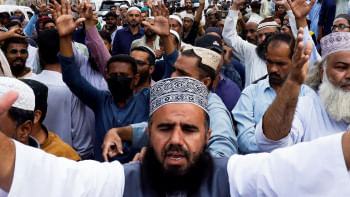
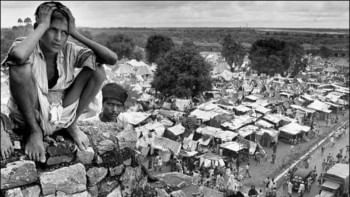
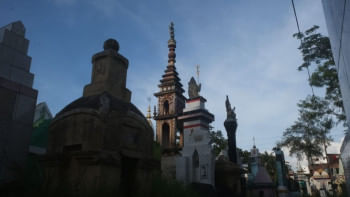





Comments